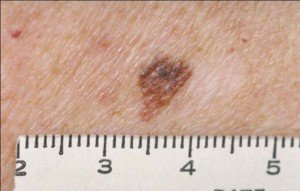
Melanoma: What can cause a mole to change besides skin cancer?
We’ve been alarmed by the media when it comes to changing moles — to See your doctor immediately if you have a changing mole to rule out skin cancer.
The words changing mole can dredge up the deepest fear in many people: skin cancer.
“Moles, just like the rest of our bodies, can change over time,” says Adarsh Vijay Mudgil, MD, double board certified in dermatology and dermatopathology, and founder of Mudgil Dermatology in NY.
“Subtle change over the course of years is not a melanoma,” continues Dr. Mudgil.
“Drastic change (multiple colors within a pre-existing monochromatic lesion, rapid growth, etc.) can indicate trouble, and any such lesion should be biopsied.”

Melanoma
However, melanoma usually will not cause changes in a mole that you can detect from one day to the next.
Melanoma skin cancer kills about 9,000 Americans yearly. Skin cancer can also disfigure.
- So what can cause a mole to change besides skin cancer?
- If 1,000 people have a changing mole, nobody knows how many of those will be melanoma.
If you have a changing mole, you should immediately make an appointment with a dermatologist.
But what can cause a mole to change besides skin cancer?
Follicular irritation. Some moles have a hair growing out of them. If the follicle, from which the hair grows, becomes irritated, this can cause the top layer of the mole to flake off.
This is what my dermatologist told me after she examined a changing mole on my face (biopsy was normal).
The entire layer could be gone in under two weeks: a rapidly changing mole that can scare the pants off of anyone conscious of skin cancer.
Lighting and shadows. It’s amazing how lighting-changes can create the illusion of a changing mole.
Make sure that you always check your moles in the exact same location of the house, and always under the same lighting conditions.
This means the same number of lights are used that shine above the sink mirror, for instance, or the dimmer switch is always on all the way.
Same time of day is best, and make sure light from a window is the same (i.e., curtains always drawn, or shade always up, etc.).
Variations in lighting can make a mole look like it’s changing, in that it will appear lighter or darker than usual, due to lighting fluctuations.
A light source above can also create an illusion that the top-half of the mole’s border has developed a white outline.
This is something you may have never noticed before, and because of that, the mole is “changing” and you fear skin cancer.
Skin cancer can turn parts of a mole white. When examining, examine from the same angles.
A change in angle can result in the appearance of a partially white border, created by a bright light source above.
More Causes that Aren’t Skin Cancer
Body position. Some moles, due to location, require some body contortion to get the best view. Or do they? Be aware of body contortions.

Shutterstock/Albina Glisic
One day a mole on my back appeared to be smaller and rounder: changing.
It took a few days for me to figure out that it “became” smaller and rounder when both shoulders were relaxed.
Historically, I had viewed it (during monthly skin exams) with one shoulder jutted up and forward, my back slightly twisted.
The mole is on my back and thus, I somewhat contorted myself, while sitting on the sink, to get the best, head-on view.
But this twisting and uneven shoulders stretched the skin, thereby “expanding” the mole and lessening its naturally round shape. I was used to seeing it this way.
So on the day I just happened to view it with a straight back and no jutting shoulder, it was actually its normal shape.
But because I wasn’t used to viewing it this way, I thought the mole was changing.
Always use the same body position when examining in hard-to-view locations.
Hair. I noticed that the top of a mole on my back was white, but not the same kind of white as mentioned prior. I had never noticed this before.
After a number of examinations at different angles, I discovered that the white was actually the bright light glinting off a hair just above the mole! I then began spotting other “white” hairs nearby.
If I angled my back a certain way, the white part morphed into a full-fledged hair.
The human back is full of hairs if you look closely. My back looks completely void of hair until I look closely, and then I see a ton of very short, very light hairs. This mole just happened to be smack under a hair.
Soap. One day I noticed a mole on my thigh looked a little different and had a whitish tinge to it.
It had a line down the middle I’d never seen before. The mole isn’t that big, but I could discern a line or divider down its center.
I placed my finger on it and felt texture. I’d never been able to feel it before. A mole can change by becoming elevated and changing color.
I then rubbed my finger across it and it instantly changed, appearing more like it always had.
I rubbed several times, and the white kind of flaked off it, and voila, it appeared the way it always had.
I then realized that earlier that day, soap suds had cascaded down my legs, and the mole was smack in the path. The whitish tinge and divider line had been caused by dried soap.
“It’s easy to lose the forest for the trees,” says Dr. Mudgil. “As a dermatopathologist, the majority of pigmented lesions I read are 100% benign.
“The key when examining a patient is looking for the outlier — a mole that is significantly different in appearance than what a patient naturally makes.”
 Dr. Mudgil treats infant to geriatric patients, and is versed in all aspects of medical, surgical and cosmetic dermatology. He has published extensively in the medical literature plus has lectured at numerous national meetings.
Dr. Mudgil treats infant to geriatric patients, and is versed in all aspects of medical, surgical and cosmetic dermatology. He has published extensively in the medical literature plus has lectured at numerous national meetings.
 Lorra Garrick has been covering medical, health and personal security topics for many years, having written thousands of feature articles for a variety of print magazines and websites. She is also a former ACE-certified personal trainer.
Lorra Garrick has been covering medical, health and personal security topics for many years, having written thousands of feature articles for a variety of print magazines and websites. She is also a former ACE-certified personal trainer.








































